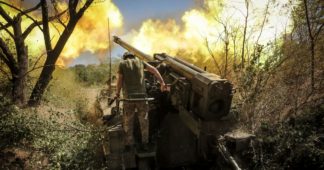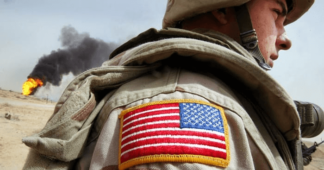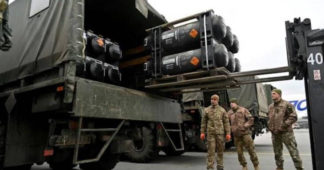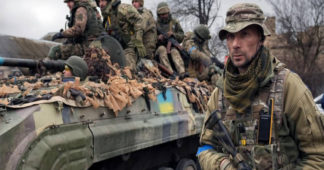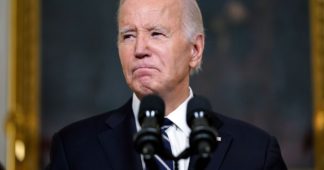by Ted Snider
April 04, 2025
A March 29 article on America’s involvement in the war in Ukraine in The New York Times by Adam Entous “reveals that America was woven into the war far more intimately and broadly than previously understood.” “Understood” is a euphemism. It means the American and global public were lied to.
The article reveals that the war in Ukraine truly was, as former British prime minister Boris Johnson and U.S. secretary of state Marco Rubio have already said, a proxy war against Russia. U.S. military and intelligence were involved in every stage of the war, including supplying the weapons, the training, the planning, the war-gaming, the intelligence and the targeting. They were involved in everything from the big picture to the minute detail: “A vast American intelligence-collection effort both guided big-picture battle strategy and funneled precise targeting information down to Ukrainian soldiers in the field.”
American military and intelligence provided “intelligence about Russian battlefield positions, movements and intentions.” “Every morning, officers recalled, the Ukrainians and Americans gathered to survey Russian weapons systems and ground forces and determine the ripest, highest-value targets.” When a “European intelligence chief” discovered how “deeply enmeshed” NATO was in the battlefield operations, he marveled that “They are part of the kill chain now.”
But none of this is really new. For those paying attention to the news, and not the propaganda and repeated assurances and talking points, this information was readily available. Even The New York Times had already reported much of it. The Entous piece adds many names and significant details, but it is not a revelation that the U.S. was not only supplying the Ukrainian armed forces the weapons but that it was feeding them the intelligence.
But beneath the supposed bombshell, important nuggets are exposed that deserve more attention. Though, again, not entirely new, the piece opens with the revelation – intended as dramatic narrative and not investigative journalism–that from early in the war, NATO troops were on the ground in Ukraine. In the dramatic description of a clandestine convoy that smuggled two Ukrainian generals across the Polish border to meet with American intelligence and military officials to “forge what would become one of the most closely guarded secrets of the war in Ukraine,” The Times reveals that the convoy was “manned by British commandos, out of uniform but heavily armed.”
That’s not entirely news. Nor is it entirely news that “American military advisers were dispatched to Kyiv.” It may be news that the Biden administration sent “a small team, about a dozen officers, to Kyiv, easing the prohibition on American boots on Ukrainian ground,” and then, “to build confidence and coordination, the administration more than tripled the number of officers in Kyiv, to about three dozen; they could now plainly be called advisers, though they would still be confined to the Kyiv area.” But it is significant that “The C.I.A. was also authorized to send officers to the Kharkiv region to assist their Ukrainian counterparts with operations inside the box.” “Inside the box” means inside Russia. “The unthinkable had become real,” Entous says. “The United States was now woven into the killing of Russian soldiers on sovereign Russian soil.” Soon, military advisers would be dispatched to “command posts closer to the fighting.”
The creeping closer to the front of U.S. military advisers hints at how far the U.S. stretched its restrictions and became involved in strikes inside Russia. It began with Crimea, regarded by Russians as their own. American intelligence and targeting information allowed the killing of Russian generals. “[W]ith leeway to act within Crimea itself,” the CIA supported a massive attack by maritime drones on the Russian Black Sea Fleet in the Crimean port of Sevastopol. Later the U.S. military and the CIA would help “plan and support a campaign of Ukrainian strikes in Russian-annexed Crimea.”
In an operation code-named “Lunar Hail,” the Biden administration authorized Ukraine to attack Crimea with long-range missiles and drones with the aim of forcing Russia “to pull their military infrastructure out of Crimea.” The U.S. would select the targets and “oversee virtually every aspect of each strike, from determining the coordinates to calculating the missiles’ flight paths.” The Biden administration even “authorized the military and C.I.A. to secretly work with the Ukrainians and the British on a blueprint of attack to bring the [Kerch Strait] bridge down.”
By the end “the military and then the C.I.A. received the green light to enable pinpoint strikes deep inside Russia itself.” Since the CIA was not allowed to provide targeting information inside Russian territory, in an act of sophistry, “the administration would let the C.I.A. request “variances,” carve-outs authorizing the spy agency to support strikes inside Russia to achieve specific objectives.” The CIA provided details on Russian “vulnerabilities,” as well as intelligence on Russian defense systems. “They calculated how many drones the operation would require and charted their circuitous flight paths.”
The Times article reveals, perhaps in clearer detail than before, how these escalations recklessly led the Biden administrations to repeatedly cross red lines, creating consequences that had them genuinely concerned about World War 3 and even nuclear war.
When the U.S. first provided longer-range HIMARS rocket systems, which rely on U.S. satellites for their flight paths, a U.S. official reflected that “the moment felt like ‘standing on that line, wondering, if you take a step forward, is World War III going to break out?’”
In their calculations, the U.S. knew that Russian nuclear doctrine hypothetically allows for the use of nuclear weapons if “the very existence of the state is threatened.” They knew, too, that Russia considers Crimea to be part of the Russian state. U.S intelligence had “overheard Russia’s Ukraine commander, Gen. Sergei Surovikin, talking about… using tactical nuclear weapons to prevent the Ukrainians from crossing the Dnipro and making a beeline to Crimea.” Estimating that it would raise “the chance of Russia’s using nuclear weapons in Ukraine” to “50 percent,” the Biden administration authorized Operation Lunar Hail anyway.
They would repeat that risk with the introduction of the longer-range ATACMS, knowing that “Russia’s military chief, General Gerasimov, had indirectly referred to them the previous May when he warned General Milley that anything” with their longer-range “would be breaching a red line.” The “final red line” would be crossed when the CIA was authorized “to support long-range missile and drone strikes into… Russia.”
In addition to the reckless flirtation with World War 3 and a nuclear war for which history should hold the Biden administration accountable, The Times article reveals another cynical nugget that has not previously been enough reported.
The war against Russia in Ukraine “was also a grand experiment in war fighting, one that would not only help the Ukrainians but reward the Americans with lessons for any future war.” In an episode meant more as poignant drama than investigative journalism, Entous misses the significance of his own reporting. As Lt. Gen. Christopher T. Donahue, the head of the coalition supporting Ukraine, ended his deployment and prepared to leave, he presented Ukrainian general Zabrodskyi a gift and said, “Thanks.” When the Ukrainian general asked him, “Why are you thanking me? I should say thank you,” Donahue “explained that the Ukrainians were the ones fighting and dying, testing American equipment and tactics and sharing lessons learned. ‘Thanks to you,’ he said, ‘we built all these things that we never could have.’”
Missing from the story, is that the Russian armed forces also met and adapted to the most advanced American systems, learning how to defend against and eliminate many of them.
The New York Times article is characterized by other oddities. As Geoffrey Roberts, Professor Emeritus of history at University College Cork, pointed out to me, in Entous’ account, the Russian armed forces play no role. In a peculiar narrative that differs significantly from more authoritative ones, like the one told in the relevant chapters of The Routledge Handbook of Soviet and Russian Military Studies, edited by Alexander Hill, the “incompetent” Russian armed forces are only ever reactive. They are missing from the story. The Russians have no battlefield successes, only passive responses to Ukrainian failures.
In a war that has swung decisively in Russia’s favor, the American-Ukrainian “partnership” is portrayed as “yield[ing] triumph upon triumph.” Even most of Ukraine’s catastrophic failures are presented as yielding some success. In the face of partnership victories, Russian forces’ “morale plummeted, and with it their will to fight.” An odd account of a war Russia is winning.
But perhaps most importantly, the article reads like a history intended to prepare the American public for defeat in Ukraine. Every victory is credited to America; every defeat is blamed on Ukraine. To read the article is to learn that Ukraine would have won the war had they only listened to the Americans.
The Times article is a flipping of the script. Ukraine has blamed the U.S. for its failure, pointing to a failure to keep its promise of whatever they need for as long as they need it. Ukrainian President Volodymyr Zelensky may have meant his Ukraine Victory Plan to allow him to claim that he has begged the U.S. to keep its promise to no avail. They had broken their promise and abandoned him, leaving no choice but to concede defeat and turn to negotiations. The Times article flips the script: the U.S. did everything they could do, but the Ukrainians wouldn’t listen. That is why the war was lost, and now we have no choice but to force negotiations.
There are too many examples of the U.S. receiving credit for every victory and Ukraine receiving blame for every failure to quote them all. “The Americans,” we are told, “sometimes couldn’t understand why the Ukrainians didn’t simply accept good advice.” An American general told a Ukrainian general, “I love your country. But if you don’t do this, you’re going to lose the war.” The humbled general replied that he gets it, but that he is “not the supreme commander. And I’m not the president of Ukraine.” On another occasion, the same American general told the Ukrainians, “You can ‘Slava Ukraini’ all you want with other people. I don’t care how brave you are. Look at the numbers,” before “walk[ing] them through a plan to win a battlefield advantage.”
When the Ukrainian armed forces had an “important” early “victory,” against Russian soldiers attempting to build a bridge they could cross over a river, “[u]spoken was that the Americans had supplied the points of interest [targets] that helped thwart the Russian assault.” Time and time again, when battles failed, it was because “the Americans were informed that the order of battle had changed” or Ukrainian generals “had other plans” or the “Americans were not told the meeting’s outcome.” “That’s not the plan!” the exasperated American generals would cry. “All we kept thinking,” a senior U.S. official reports, “was, this is not great.”
The Americans meticulously laid out each operation. But each time they failed, it was because “[t]he Ukrainians wavered” or their generals “wouldn’t budge” or, when the U.S. generals “were begging” the Ukrainian general “to move his brigades forward… The Ukrainian commander hesitated.” The crucial counteroffensive failed because the “key” was “beginning the counteroffensive on schedule,” but the “drop-dead date came and went” because “the Ukrainians wouldn’t commit.” A frustrated senior U.S. official said that “We should have walked away.”
Later missions would fail because, out of “caution and a deficit of trust,” Ukrainian commanders would now “first use drones to confirm the [U.S.] intelligence,” costing precious time. In the end, Ukraine fell short because they “weren’t willing to do what was necessary to help themselves prevail” by drafting people as young as 18, despite all the legitimate reasons for not doing so that the Americans were deaf to because they prioritized their goals in the proxy war over Ukraine’s concerns.
The New York Times article reveals many gems, sometimes not the ones it set out to. Its cataloguing of just how much the U.S. was “woven into the war” should also, as Anatol Lieven, director of the Eurasia program at the Quincy Institute for Responsible Statecraft, suggested to me, remind the Europeans, with their ambitious ideas of continuing to support the war without the Americans, how crucial U.S. aid. But the most important revelation of the article is that it is the first significant public attempt to prepare Americans for defeat in a war that cost them billions of dollars and the Ukrainians hundreds of thousands of casualties and lives.
We remind our readers that publication of articles on our site does not mean that we agree with what is written. Our policy is to publish anything which we consider of interest, so as to assist our readers in forming their opinions. Sometimes we even publish articles with which we totally disagree, since we believe it is important for our readers to be informed on as wide a spectrum of views as possible.
